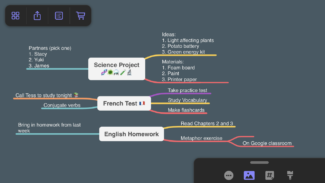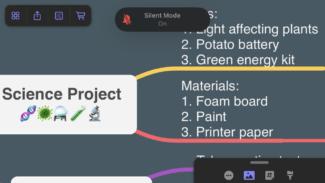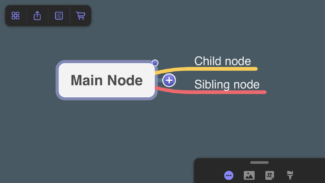Habit Rabbit
LQ: 9.2
Recommended Age: 4+
Skills Used: Focus, Organization, Mathematics, Writing

 Mindnode is an idea organization app where the user builds mind maps with branching subject matter by using their device’s touchscreen. To begin, the user creates a core idea, or “main” node which is the overarching idea for their thought map. The user can then add a subcategory, or “child” node to build off of that main idea. Additional ideas, or “sibling” nodes can then be added to further flesh out the main idea. Child nodes can then be added onto these nodes, eventually building out a branching map of thoughts and ideas.
Mindnode is an idea organization app where the user builds mind maps with branching subject matter by using their device’s touchscreen. To begin, the user creates a core idea, or “main” node which is the overarching idea for their thought map. The user can then add a subcategory, or “child” node to build off of that main idea. Additional ideas, or “sibling” nodes can then be added to further flesh out the main idea. Child nodes can then be added onto these nodes, eventually building out a branching map of thoughts and ideas.
Users can also add notes and tags to their maps, helping them locate their ideas quickly. Different stickers and color themes can then be added to customize your mind map just the way you want.
The Outline feature can also be used either on its own or side by side with your mind map. This mode takes your mind map and puts it into a traditional outline format, making the organization of your thoughts more straightforward and easier for some users in regards to planning out projects and papers.
Mindnode is free but certain features such as notes and tags require purchasing the Pro version of the app.
Organization: Arranging and coordinating materials in order to complete a task.
 Mind maps are a great way for kids to practice their organization skills. By taking the ideas in their head and creating a mind map, they are giving a visual representation to their thoughts, making them more concrete. By creating main nodes and then branching out with child and sibling nodes, they are able to see exactly where their thoughts fit into the main idea of what they are trying to accomplish. Because the user can also delete, move, and otherwise manipulate the mind map, they can arrange their thoughts easily once they are written down in this easy to visualize method.
Mind maps are a great way for kids to practice their organization skills. By taking the ideas in their head and creating a mind map, they are giving a visual representation to their thoughts, making them more concrete. By creating main nodes and then branching out with child and sibling nodes, they are able to see exactly where their thoughts fit into the main idea of what they are trying to accomplish. Because the user can also delete, move, and otherwise manipulate the mind map, they can arrange their thoughts easily once they are written down in this easy to visualize method.
Planning: Developing a systematic approach for setting and achieving goals.
 For children who need to complete a large task such as a science project or a book report, mind mapping can be extremely useful for planning out what needs to be done in order to complete all necessary tasks. For children who struggle with planning in general, mind mapping is also a great way to think through the possible outcomes of a project and give concrete visuals to their thoughts. For example, if a child needs to complete a science project but doesn’t even know where to begin, a mind map can help them brainstorm their list of topics, think about what classmates to partner up with, what materials they will need, etc. Once the ideas are down in the mind map, they can then begin to plan out what course of action will be the most beneficial.
For children who need to complete a large task such as a science project or a book report, mind mapping can be extremely useful for planning out what needs to be done in order to complete all necessary tasks. For children who struggle with planning in general, mind mapping is also a great way to think through the possible outcomes of a project and give concrete visuals to their thoughts. For example, if a child needs to complete a science project but doesn’t even know where to begin, a mind map can help them brainstorm their list of topics, think about what classmates to partner up with, what materials they will need, etc. Once the ideas are down in the mind map, they can then begin to plan out what course of action will be the most beneficial.
All membership plans come with full access to our entire suite of tools learning guides, and resources. Here are a few of the ones we think you’ll like the most: